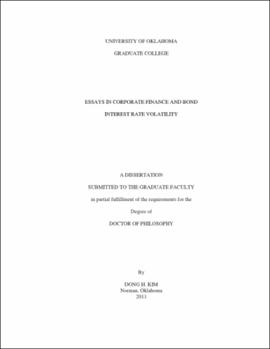| dc.description.abstract | This dissertation is a collection of three essays in corporate finance and bond interest rate volatility. Chapter 1 investigates the impact of TARP preferred stock on two different types of outstanding preferred stock. The October 14, 2008 TARP program mandated a forced issuance of TARP preferred stock by the largest U.S. banks. Soon after, many smaller banks were not forced but chose to issue TARP preferred stock after being approved for issuance. We investigate the impact of TARP preferred on two different types of outstanding preferred stock. These two different types of preferred stock are (1) trust preferred stock, which is senior to TARP preferred stock, and (2) non-trust preferred stock, which has equal claim to TARP preferred stock. We present competing theories for expecting that trust preferred should enjoy greater or lesser returns relative to non-trust. Consistent with the priority rule theory, but inconsistent with the default theory, we find that trust preferred enjoyed greater benefits from TARP issuance than did non-trust preferred for both forced and non-forced banks on the October 14 TARP announcement date. In contrast, there is no clear priority rule effect on the approval dates for non-forced banks. Chapter 2 examines whether share ownership structure plays a role in determining the ex-day pricing of dividends. If share ownership structure, specifically the proportion of the firm's stock held by individuals versus institutions, has an effect on the ex-dividend day stock price behavior, the ex-day premium is expected to be different for firms with different ownership structures. Consistent with both the tax-based theory and the dynamic trading clientele theory, I find that the ex-day premium decreases with the level of individual ownership. Consistent with the short-term trading theory, I also find that the ex-day premium increases with the degree of investor heterogeneity, defined as the product of the proportion of the firm's stock held by individual investors and the proportion held by institutional investors. The results suggest that the cross-sectional variation in the ex-day premium is related to the firm-specific share ownership structure. In addition, I find that the ex-day premium is positively related to the ex-day excess trading volume, indicating that a high level of dividend capture increases the ex-day premium. Chapter 3 investigates the relationship between interest rate volatility and yield spreads on noncallable bonds. If greater interest rate volatility increases a firm's debt volatility, the firm is more likely to reach a critical value for default, thereby leading to a higher yield spread. We find that interest rate volatility is positively related to yield spreads on noncallable bonds. Our finding is consistent with the structural models of default, which suggest that a firm's volatility should include its debt volatility as well as its equity volatility. This study also explores whether the positive effect of interest rate volatility on yield spreads is stronger or weaker for callable bonds than for noncallable bonds. We find that the positive effect of interest rate volatility on yield spreads is weaker for callable bonds. This result indicates there is a negative relation between default spreads and call spreads, which is consistent with Acharya and Carpenter (2002) but in contrast to King (2002). | |
